|
|
 |
Fiche d'espèce de Copépode |
|
|
Calanoida ( Ordre ) |
|
|
|
Diaptomoidea ( Superfamille ) |
|
|
|
Acartiidae ( Famille ) |
|
|
|
Acartia ( Genre ) |
|
|
|
Acartiura ( Sous-Genre ) |
|
|
| |
Acartia (Acartiura) longiremis (Lilljeborg, 1853) (F,M) | |
| | | | | | | Syn.: | Dias longiremis Lilljeborg, 1853; Brady, 1878 (p.51); Giesbrecht, 1882; Bourne, 1889 (p.147, figs.F,M), Rem.);
no Acartia longiremis spinifer Krichagin,1873; Bradford, 1976 (p.195: Rem.)
| | | | Ref.: | | | Giesbrecht, 1892 (p.507, 522, figs.F,M); Giesbrecht & Schmeil, 1898 (p.153); Sars, 1900 (p.106); Sars, 1903 (p.149, figs.F,M); Willey, 1920 a (p.20); Steuer, 1923 (p.8, figs.F,M); Sars, 1925 (p.361); Rose, 1929 (p.47); Campbell, 1929 (p.319, Rem.); Steuer, 1929 (p.502); Wilson, 1932 a (p.165, figs.F,M); Rose, 1933 a (p.271, figs.F,M); Jespersen, 1934 (p.120, figs.30, 31, Rem.); Mori, 1937 (1964) (p.104, figs.F,M); Jespersen, 1940 (p.69); Farran, 1948 a (n°12, p.3, figs.F); Brodsky, 1950 (1967) (p.421, figs.F,M); Davis, 1949 (p.65, Rem.F,M); Marques, 1951 a (p.14, fig.M); Chiba & al., 1957 a (p.12); Grainger, 1962 (p.390, figs.juv.,M); Fish, 1962 (p.19); Marques, 1966 (p.9, fig.M); Minoda, 1971 (p.43); Sullivan & al., 1975 (p.176, fig.Md); Kos, 1976 (Vol. II, fios.F, M, Rem.); Bradford, 1976 (p.194, fig.M, Rem.); Schnack, 1982 (p.89, figs.Mx2, Md, Mxp); Gardner & Szabo, 1982 (p.418, figs.F, M); Kos, 1984 (1985) (p.243, figs.F,M, Rem.); Ohtsuka & al., 1996 b (p.153, figs.F, mouth parts, gut contents); Behrends & al., 1997 (p.594, figs.F); Chihara & Murano, 1997 (p.670, Pl.16: F,M); Bradford-Grieve, 1999 (n°181, p.4, figs.F,M ); Barthélémy, 1999 (p.858, 863, fig.F); 1999 a (p.9, Fig.22, G); Caudill & Bucklin, 2004 (p.91, molecular biology); G. Harding, 2004 (p.23, figs.F,M); Avancini & al., 2006 (p.110, Pl. 78, figs.F,M, Rem.);Vives & Shmeleva, 2007 (p.422, figs.F,M, Rem.) | 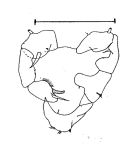 issued from : J. M. Bradford in N.Z. J. Mar. Freshw. Res., 1976, 10 (1). [p.196, Fig.32a]. Male (From Norway): P5 (posterior view). Scale bar = 0.1 mm.
|
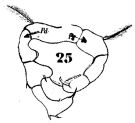 issued from : W. Giesbrecht in Fauna Flora Golf. Neapel, 1892, 19. [Taf.43, Fig.25]. Male: 25, P5 (left leg); Pd = right leg).
|
 issued from : W. Giesbrecht in Fauna Flora Golf. Neapel, 1892, 19. [Taf.43, Fig.17]. Female: 17, habitus (dorsal).
|
 issued from : W. Giesbrecht in Fauna Flora Golf. Neapel, 1892, 19. [Taf.30, Fig.25]. Female: 25, P5
|
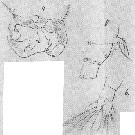 issued from : G.C. Bourne in J. Mar. biol. Ass. U.K., 1889, n. ser. 1. [Pl.XII, Figs.4-6]. As Dias longiremis. Female (from Plymouth): 5, last thoracic segment and first two urosomal segments showing the spines. Male: 4, P5; 6, caudal rami (dorsal).
|
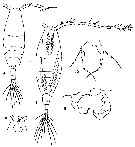 issued from : T. Mori in The pelagic Copepoda from the neighbouring waters of Japan, 1937 (2nd edit., 1964). [Pl.51, Figs.6-10]. Female: 7, habitus (dorsal); 8, forehead (ventral); 10, P5. Male: 6, habitus (dorsal); 9, P5.
|
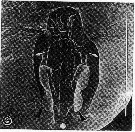 issued from : R.-M. Bathélémy in J. Mar. Biol. Ass. U.K., 1999, 79. [p.860, Fig.3, G]. Scanning electon miccrograph. Female (from Polar Sea): G, genital area (external ventral view); note the two lengthened genital slits (small arrows) each protected by a lamellar flap (arrowheads). Scale bar: 0.0.030 mm. Symbol: * = fixation site of the spermatophore.
|
 issued from : A. Steuer in Arb. zool. Inst. Innsbruck, 1923, 1 (5). [p.8, Figs. 15, 16, 18]. Female: 15, urosome (dorsolateral). Male: 16, urosome (dorsal); 18, P5.
|
 issued from : A. Steuer in Arb. zool. Inst. Innsbruck, 1923, 1 (5). [Taf. II, Figs.4, 5]. Female: genital segment (lateral); 5, idem (ventral).
|
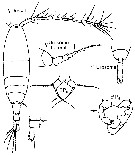 issued from : G. Harding in Key to the adullt pelagic calanoid copepods found over the continental shelf of the Canadian Atlantic coast. Bedford Inst. Oceanogr., Dartmouth, Nova Scotia, 2004. [p.23]. Female & Male.
|
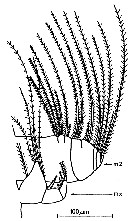 issued from : S.B. Schnack in Crustacean Issue, 1989, 6. [p.140, Fig.3]. Mx2 (m2) and Mxp (mx) of Acartia longiremis. Nota: In the genus Acartia the Mxp are smaller than the Mx2, although they belong to the mixed-mode feeders (see in Conover, 1956; Gauld, 1966; Schnack, 1982 a).
|
 issued from : B.K. Sullivan, C.B. Miller, W.T. Peterson & A.H. Soeldner in Mar. Biol., 1975, 30. [p.179, Fig.4, C]. Acartia longiremis (from 44°40'N, 124°10'W) female: C, SEM of right Md (detail of the ventral end).
|
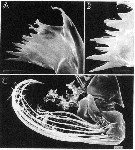 Issued from : S. Ohtsuka, M. Shimozu, A. Tanimura, M. Fukuchi, H. Hattori, H. Sasaki & O. Matsuda in Proc. NIPR Symp. Polar Biol., 1996, 9. [p.157, Fig.3]. Acartia longiremis Female (from Bering Sea, Chukchi Sea): A, Mandibular cutting efge; B, dorsal teeth of mandibular cutting edge;C, Maxilla praecoxal and coxal endites (arrowed). Scale 10 µm (A, C); 5 µm (B).
|
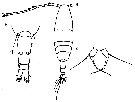 Issued from : M. Chihara & M. Murano in An Illustrated Guide to Marine Plankton in Japan, 1997. [p.674, Pl. 16, fig.5 a-c]. Female: a, habitus (dorsal); b, last thoracic segment and urosome (dorsal); c, P5.
|
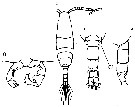 Issued from : M. Chihara & M. Murano in An Illustrated Guide to Marine Plankton in Japan, 1997. [p.674, Pl. 21, fig.5 d-g]. Male: d, habitus (dorsal); e, last thoracic segment and urosome (dorsal); f, same (lateral, left side).
|
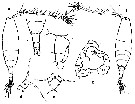 Issued from : M.G. Mazzocchi in Guida al Riconoscimento del plancton dei Mari Italiani, Vol. II, 2006. [p.86, Tav. 78]. After A. Comaschi. Female: a, habitus (dorsal); b, posterior part of prosome and urosome (dorsal); c, urpsome with spermatophore (lateral); d, left P5; e, P5. Male: f, habitus (dorsal); g, P5.
|
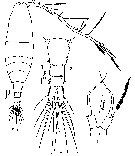 Issued from : M.S. Kos in Issled. Fauny Morei, 1984 (1985), 30 (38). [p.244, Fig.10]. Female (from South Sakhalin Islands): 1, habitus (dorsal); 2, abdomen (dorsal); 3, P5.
|
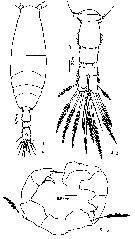 Issued from : M.S. Kos in Issled. Fauny Morei, 1984 (1985), 30 (38). [p.245, Fig.11]. Male (from South Sakhalin Islands): 1, habitus (dorsal); 2, abdomen (dorsal); 3, P5.
| | | | | Ref. compl.: | | | Vanhöffen, 1897 a (p.281); Mrazek, 1902 (p.510, 523); I.C. Thompson, 1903 a (p.31); Thompson & Scott, 1903 (p.236, 254); Pearson, 1906 (p.31, Rem.); Lysholm, 1913 (p.7); Rose, 1926 (p.47, Rem.); Gurney, 1927 (p.155: Rem.); Wilson, 1932 (p.20); Jespersen, 1939 (p.71, Rem.); Bogorov, 1939 b (p.707); Wilson, 1942 a (p.169); Lysholm & al., 1945 (p.42); Sewell, 1948 (p.367, 483, 487); C.B. Wilson, 1950 (p.155); Gundersen, 1953 (p.1, 24, Table 20, seasonal abundance); Minoda, 1958 (p.253, Table 1, abundance); Deevey, 1960 (p.5, tab.II, annual abundance); M.W. Johnson, 1961 (p.311, Table 2); Bowman, 1961 (p.206, Rem.); Fagetti, 1962 (p.37) ; Grice & Hart, 1962 (p.287, 295: Rem.; Grice, 1962 a (p.101); Fish, 1962 (p.19, fig.F, Rem.); Björnberg, 1963 (p.67, Rem.); Northcote & al., 1964 (p.1069, Table II); Martin, 1965 (p.188); Mazza, 1966 (p.72); Motoda, 1966 (p.260); Ehrhardt, 1967 (p.741, geographic distribution, Rem.); Matthews, 1967 (p.159, Table 1, Rem.); Maclellan D.C., 1967 (p.101, 102: occurrence); Pertsova, 1967 (p.240); Evans, 1968 (p.11); Vinogradov, 1968 (1970) (p.51); Shih & al., 1971 (p.30, 142, 200); Salah, 1971 (p.320); Apostolopoulou, 1972 (p.329, 371); Björnberg, 1973 (p.353); Arndt & Heidecke, 1973 (p.599, 603); Eriksson, 1973 (p.37, fig.22-25, annual cycle); 1973 b (p.113, 117); Peterson & Miller, 1975 (p.642, 650, Table 3, interannual abundance); 1976 (p.14, Table 1, 2, 3, abundance vs interannual variations); Lakkis & Abboud, 1976 (p.81); Eriksson, 1976 (p.155, annual cycle-temperature occurrences); Davis C.C., 1976 (p.37, fig.2, reproductive characteristics); Peterson & Miller, 1977 (p.717, Table 1, seasonal occurrence); Falconetti & Seguin, 1977 (p.188); Gibson & Grice, 1977 (p.85, Table 1, copper pollution); Kolosova, 1978 (p.320); Hernroth, 1978 (p.1, Rem.: p.5); Peterson & al., 1979 (p.467, Table 1, fig.7, 10); Lee & McAlice, 1979 (p.228, annual cycle); Gagnon & Lacroix, 1981 (p.401, fig.5, Table 1, tidal effect); 1982 (p.9, fig.4, Table I); Citarella, 1982 (p.791, 798: listing, frequency, Tableau II, V); Mackas & Sefton, 1982 (p.1173, Table 1); Buchanan & Sekerak, 1982 (p.41, vertical distribution); Vives, 1982 (p.295); Kovalev & Shmeleva, 1982 (p.85); Turner & Dagg, 1983 (p.16); Gagnon & Lacroix, 1983 (p.289, fig.2, Table III, tidal estuary); Huntley & al., 1983 (p.143, Table 2); Chojnacki, 1983 a (p.435, length-weight relation); Chojnacki & Hussein, 1983 (p.53, Table 5, length-weight); Maranda & Lacroix, 1983 (p.247, estuary); Nishiyama & Hirano, 1983 (p.159, Table 4: length-weight); Hernroth, 1983 (p.835, Rem.: p.840); Tremblay & Anderson, 1984 (p.3); De Ladurantaye & al., 1984 (p.21, tab.I, fig.3, 4, 5, advective processes in fjord); Regner, 1985 (p.11, Rem.: p.39); Moraitou-Apostolopoulou, 1985 (p.303, occurrence/abundance in E Mediterranean Sea, Rem.: p.310); Mackas & Anderson, 1986 (p.115, Table 2); Yamamoto & Nishizawa, 1986 (p.1729, horizontal distribution); Mikhailovsky, 1986 (p.83, Table 1, ecological modelling); Tiselius, 1988 (p.215, grazing); Springer & al., 1989 (p.359, Fig.5), Citarella, 1989 (p.123, abundance); Lakkis, 1990 (p.63); Marcus, 1990 (p.414: tab.1); Norrbin & al., 1990 (p.205, lipids: seasonal variation); Coyle & al., 1990 (p.763); Fransz & al., 1991 (p.10); Shih & Marhue, 1991 (tab.2, 3); Conover & Huntley, 1991 (p.1, fig.4, Table 2, 3); Naas & al., 1991 (p.161, natural production in mesocosm ecosystem); W.T. Peterson & al., 1991 (p.131, egg production, growth rates, secondary production); Norrbin, 1992 §P1, life history, egg production); Viitasalo, 1992 (tab.2); Seguin & al., 1993 (p.23); Norrbin, 1994 (p.115, gonad maturation, sex ratio); Vinogradov & al., 1994 (tab.1); Shih & Young, 1995 (p.66); Krause & al., 1995 (p.81, Rem.: p.138); Petryashov & al., 1995 (tab.1); Kotani & al., 1996 (tab.2); Abramova, 1996 (tab.1); Norrbin, 1996 (p.99, life history, timing of diapause); Behrends & al., 1997 (p.594); Hanssen, 1997 (tab.3.1); Hure & Krsinic, 1998 (p.103); Suarez-Morales & Gasca, 1998 a. (p107); Tsuda & al., 1998 (p.1944, copepod gut content vs. predator); Kosobokova & al., 1998 (tab.2); Mauchline, 1998 (tab.21, 38, 40, 48, 58); Gomez-Gutiérrez & Peterson, 1999 (p.637, Table I, II, III, VI, figs.4, 5, 6, 7, abundance, egg production); Halvorsen & Tande, 1999 (p.279, fig.3); Bragina, 1999 (p.196); Abramova, 1999 (p.161, Table 2); B.W. Hansen & al., 1999 (p.233, seasonal abundance & biomass); Harvey & al., 1999 (p.1, 49: Appendix 5, in ballast water vessel); Pinchuk & Paul, 2000 (p.4, table 1, % occurrence); Kosobokova & Hirche, 2000 (p.2029, tab.2); Levinsen & al., 2000 (p.65); El-Sherif & Aboul Ezz, 2000 (p.61, Table 3: occurrence); Harvey & al., 2001 (p.481); Belmonte & Potenza, 2001 (p.174); Musaeva & Suntsov, 2001 (p.511, tab.1); Mackas & al., 2001 (p.685, Tab. 3, 6, fig.3: interannual changes in species composition); Peterson & al., 2002 (p.353); Peterson & al. 2002 (p.381, Table 2, interannual abundance); Yamaguchi & al., 2002 (p.1007, tab.1); Beaugrand al., 2002 (p.179, figs.5, 6); Sameoto & al., 2002 (p.11); Ringuette & al., 2002 (p.5081, Table 1); Zerouali & Melhaoui, 2002 (p.91, Tableau I); Mackas & Galbraith, 2002 (p.725, tab.2a, 2b, fig.6,6,7); 2002 a (p.423, Table 2); Peters & Hagen, 2003 (p.197); Vukanic, 2003 (p.139, tab.1); Peterson & Keister, 2003 (p.2499, interannual variability); Keister & Peterson, 2003 (p.341, Table 1, 2, abundance, cluster species vs hydrological events); Kosobokova & al., 2003 (p.697, tab.2); Daly Yahia & al., 2004 (p.366, fig.4); Park, W & al., 2004 (p.464, tab.1); Gislason & Astthorsson, 2004 (p.472, tab.1); CPR, 2004 (p.48, fig.132); Mackas & al., 2004 (p.875, Table 2); Peters & al., 2004 (p.227, fatty acids); Mackas & Coyle, 2005 (p.707, fig.7); Choi & al., 2005 (p.710: Tab.III); Zamon & Welch, 2005 (p.133, fig.5); Manning & Bucklin, 2005 (p.233, Table 1, fig.5, fig.12); Mackas & al., 2005 (p.1011, 1021, tab.2); Mackas & al., 2006 (L22S07, Table 2); Hooff & Peterson, 2006 (p.2610); Ware & McQueen, 2006 (p.28, Table B1, weight ranges); Durbin & Casas, 2006 (p.2537, Table 2b); Papastephanou & al., 2006 (p.3078, Table 3); Hop & al., 2006 (p.182, Table 4); Deibel & Daly; 2007 (p.271, Table 4, Rem.: Arctic polynyas); Blachowiak-Samolyk & al., 2007 (p.2716, Table 2); Schulz J. & al., 2007 (p.47, vertical zonation analysis); Chojnacki & al., 2007 (p.44, Table 2); Khelifi-Touhami & al., 2007 (p.327, Table 1); Valdés & al., 2007 (p.104: tab.1); Mackas & al., 2007 (p.223, climatic change index); Blachowiak-Samolyk & al., 2008 (p.2210, Table 3, biomass, composition vs climatic regimes); Humphrey, 2008 (p.83: Appendix A); Darnis & al., 2008 (p.994, Table 1); Ohtsuka & al., 2008 (p.115, Table 5); Coyle & al., 2008 (p.1775, fig.11, abundance); DFO, 2009 (p.1, fig. 13, seasonal variability); Peterson, 2009 (p.73, Rem.: p.74, 78, indicator of long-term changes); Calliari & Tiselius, 2009 (p.111); Chiba & al., 2009 (p.1846, Table 1, occurrence vs temperature change); Hopcroft & al., 2009 (p.9, Table 3); Dvoretsky & Dvoretsky, 2009 a (p.11, Table 2, abundance); Homma & Yamaguchi, 2010 (p.965, Table 2); Hopcroft & al., 2010 (p.27, Table 1, 2, fig.9); Mazzocchi & Di Capua, 2010 (p.423); Medellin-Mora & Navas S., 2010 (p.265, Tab. 2); Fazeli & al., 2010 (p.153, Table 1, as longirenis); Dvoretsky & Dvoretsky, 2010 (p.991, Table 2); Kosobokova & al, 2011 (p.29, Table 2, 3, Fig.4, Rem.: Arctic Basins); Maiphae & Sa-ardrit, 2011 (p.641, Table 2); Matsuno & al., 2011 (p.1349, Table 1, abundance vs years); Martynova & al., 2011 (p.1175, seasonal abundance); Pepin & al., 2011 (p.273, Table 2, seasonal abundance); Dvoretsky & Dvoretsky, 2011 b (p.469, Table A, abundance, biomass); Homma & al., 2011 (p.29, Table 2, abundance, feeding pattern: suspension feeders); Keister & al., 2011 (p.2498, interannual variation); Hirche & Kosobokova, 2011 (p.2359, Table 3, abundance, biomass %); Bi & al., 2011 (L12607, time series vs decadal oscillation); Batten & Walne, 2011 (p.1643, Table I, abundance vs temperature interannual variability); Matsuno & al., 2012 (Table 2); Postel, 2012 (p.327, Table 1, Fig.6); DiBacco & al., 2012 (p.483, Table S1, ballast water transport); Salah S. & al., 2012 (p.155, Tableau 1); Sigurdardottir, 2012 (p.1, Table 2.3); Takahashi M. & al., 2012 (p.393, Table 2, water type index); Volkov, 2012 (p.474, Table 6, abundance, distribution); Gusmao & al., 2013 a (p.300, Rem., sex ratio); Schulz J. & al., 2012 (p.3, abundance vs. hydrography); Gusmao & al., 2013 a (p.300, Rem., sex ratio); Irvine & Crawford, 2013 (p.1, Rem.: p.59, anomaly time series); Dvoretsky & Dvoretsky, 2012 (p.1321, Table 2, 3, 4, 5, abundance, biomass, production); Gusmao & al., 2013 (p.279, Table 3, fig.1, sex-specific predation by fish, fig.4: seasonal variation of sex ratio); Ohashi & al., 2013 (p.44, Table 1); Questel & al., 2013 (p.23, Table 3, interannual abundance & biomass, 2008-2010); Peters & al., 2013 (p.595, seasonal variation of fatty acid, seasonal abundance); Usov & al., 2013 (p.1, interannual abundance vs temperature 1961-2010); Batchelder & al., 2013 (p.34, Rem.: p.43); Dvoretsky & Dvoretsky, 2013 a (p.205, Table 2, % abundance); Eisner & al., 2013 (p.87, Table 3: abundance vs water structure); Bonecker & a., 2014 (p.445, Table II: frequency, horizontal & vertical distributions); Mazzocchi & al., 2014 (p.64, Table 5, abundance); Zaafa & al., 2014 (p.67, Table I, occurrence): Coyle & al., 2014 (p.97, table 3, 10, 11, 12); Dias & al., 2015 (p.483, Table 2, abundance, biomass, production); Chiba S. & al., 2015 (p.968, Table 1: length vs climate); Rojas-Herrera & al., 2016 (p.40, Table 2: temporal abundance); Zakaria & al., 2016 (p.1, Table 1); Ben Ltaief & al., 2017 (p.1, Table III, Summer relative abundance); El Arraj & al., 2017 (p.272, table 2, spatial distribution); Ohtsuka & Nishida, 2017 (p.565, 578, Table 22.1); Record & al., 2018 (p.2238, Table 1: diapause); Belmonte, 2018 (p.273, Table I: Italian zones); Palomares-Garcia & al., 2018 (p.178, Table 1: occurrence); | | | | NZ: | 20 | | |
|
Carte de distribution de Acartia (Acartiura) longiremis par zones géographiques
|
| | | | | | | | | | | | | | |  Carte de 1996 Carte de 1996 | |
 issued from : P. Jespersen, 1939 in Meddr Grønland, 1939, 119 (9). [p.71, Fig. 31]. issued from : P. Jespersen, 1939 in Meddr Grønland, 1939, 119 (9). [p.71, Fig. 31].
The occurrence of Acartia longiremis at the ''Dana'' stations 1931-1933.
black circles: positive occurrence; x: negative occurrence. |
 issued from : S. Eriksson in ZOON, 1976, 4. [p.157, Fig.2]. issued from : S. Eriksson in ZOON, 1976, 4. [p.157, Fig.2].
Seasonal distribution of neritic copepod Acartia longiremis off Gothenburg (Göteborg), The Skattegatt. (Monthly means for adult specimens during 1968-1973; point : inshore, depth = 10 m; x: offshore, depth > 40 m.
The congeneric species A. clausi and A. longiremis have a tendency for seasonal separation and different temperature optima. |
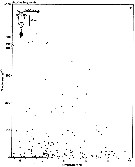 issued from : S. Eriksson in ZOON, 1976, 4. [p.159, Fig.3, e]. issued from : S. Eriksson in ZOON, 1976, 4. [p.159, Fig.3, e].
Temperature occurrence of neritic copepod Acartia longiremis off Gothenburg (Göteborg), The Skattegatt.
Surface salinity of the investigation area varies around 25 p.1000 and the deep water slinity around 34 p.1000. There is a temperature stratification with surface water warmer than 10°C from May to October with maximum of 20°C in August. The coldest period is January to March with surface temperatures of 1-2°C. The deep water ranges between 5 and 10°C.
The hauls were horizontal at 2, 20, and 40 m.
Limits subjectively regarded as the optimum temperature range: - 1 to 16°C.
|
 issued from : S. Eriksson in ZOON, 1973, 1. [p.59, Fig.25]. issued from : S. Eriksson in ZOON, 1973, 1. [p.59, Fig.25].
Size distribution of adult females of Acartia longiremis (offshore station H6:11°30' N, 57°40'.5 E, The Kattegatt) during 1969-70 in the main series. |
 issued from : S. Eriksson in Mar. Biol., 1974, 26. [p.320, Figs. 2-3] issued from : S. Eriksson in Mar. Biol., 1974, 26. [p.320, Figs. 2-3]
Salinity and temperature curves for main series at offshore station H6 (11°30' N, 57°40'.5 E, The Kattegatt) from March 1968 to November 1970. |
 issued from : J. Chojnacki & M.M. Hussein in Zesz. nauk. Akad. Roln. Szczec., 1983, 103. [p.55, Fig.1]. issued from : J. Chojnacki & M.M. Hussein in Zesz. nauk. Akad. Roln. Szczec., 1983, 103. [p.55, Fig.1].
Total length - weight relationship in selected copepod species (copepodites I to V and adults) from the eastern sector of the Southern Baltic Sea.
Animals preserved in 4 % formalin and lengths in different copepodites and adults stages measured under stereomicroscope. Volume et weight calculated according to the simplified formula (Chojnacki & al., 1980). The results in fig. 1 present mean Lt (total length values for different developmental stades (nauplii not examined) by season and area. |
 issued from : J. Chojnacki & M.M. Hussein in Zesz. nauk. Akad. Roln. Szczec., 1983, 103. [p.54]. issued from : J. Chojnacki & M.M. Hussein in Zesz. nauk. Akad. Roln. Szczec., 1983, 103. [p.54].
Total length - weight relationship calculated according to the simplified formula proposed by J. Chojnacki, P. Ciszewski & Z. Witek, 1980). |
 issued from : J. Chojnacki in Int. Revue ges. Hydrobiol., 1983, 68 (3). [p.436, Fig.1]. issued from : J. Chojnacki in Int. Revue ges. Hydrobiol., 1983, 68 (3). [p.436, Fig.1].
Length-weight relationship determined by geometrical method (pattern from calanoid-form Pseudocalanus elongatus).
Lc = cephalothorax length; La = urosome length; Lan = antennula length; h : cephalothorax height; Ra = diameter of urosome cross-section; Ran = diameter of antennula cross-section.
A conversion factor of 1.025, reflecting the density (g per cm3) of the coastal Baltic water.
The correlation coefficient for the relationship studied was found to be about 0.96. |
 Issued from : M.F. Norrbin in J. Plankton Res., 1994, 16 (2). [p.118, Fig.2]. Issued from : M.F. Norrbin in J. Plankton Res., 1994, 16 (2). [p.118, Fig.2].
Gonad maturation in A. longiremis adult females (dorsal view) from Balsfjorden (Tromsø, Norway). A: Resting stage, ovary (O) with multiplication zone. B: Maturing stage with extending diverticulae (d), maturing oocytes and visible oviducts (od). C: Reproductive female before or between broods (overwintering specimen, April 1986). D: Reproductive female under good feeding conditions (June 1986). |
 Issued from : Jan Schulz & coll. in Progr. Oceanogr., 2012, 107; [p.8, Fig.4 [modified]); Issued from : Jan Schulz & coll. in Progr. Oceanogr., 2012, 107; [p.8, Fig.4 [modified]);
Seasonal patterns in the abundance of Acartia longiremis in the Bornholm Basin (central Baltic Sea) between March 2002 and May 2003. The scaling is normalised to one and vertical lines indicate sampling dates.
Sampling performed in stacked, 10m intervals from a few meters above the seafloor to the surface with a multinet (Hydro-bios, Kiel, 50 µm mesh size) on nine focus stations.
Compare with annual cycle in Acartia bifilosa, Centropages hamatus, Temora longicornis, Oithona similis and other forms. |
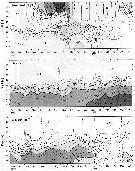 Issued from : Jan Schulz & coll. in Progr. Oceanogr., 2012, 107; [p.6, Fig.2]. Issued from : Jan Schulz & coll. in Progr. Oceanogr., 2012, 107; [p.6, Fig.2].
Vertical profiles of temperature, salinity and oxygen in the central Bornholm Basin (Baltic Sea) at position 55.3016° N, 15.7966° E. |
 Issued from : N. Usov, I. Kutcheva, I. Primakov & D. Martynova in Hydrobiologia, 2013, 706. [p.18, Fig.3]. Issued from : N. Usov, I. Kutcheva, I. Primakov & D. Martynova in Hydrobiologia, 2013, 706. [p.18, Fig.3].
Long^term dynamics of monthly temperature, salinity and Acartia longiremis abundance in the layer of 0-10 m in Chupa Inlet (Kandalaksha Bay, White Sea) from 1961 to 2010. Sampling from water layers (0-10, 10-25, and 25-45 m) using a standard Juday net (mesh size 200 µm). |
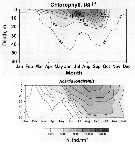 Issued from : N. Usov, I. Kutcheva, I. Primakov & D. Martynova in Hydrobiologia, 2013, 706. [p.17, Fig.2 & p.23, Fig.7]. Issued from : N. Usov, I. Kutcheva, I. Primakov & D. Martynova in Hydrobiologia, 2013, 706. [p.17, Fig.2 & p.23, Fig.7].
Long-term average of Chl a and seasonal dynamics of Acartia longiremis in Chupa Inlet (White Sea). |
| | | | Loc: | | | off Moroco, S & central Brazil (Campos Basin, ...), Barbada Is., Caribbean Colombia (Darién), Cuba, Sargasso Sea, Azores, Chesapeake Bay, Delaware Bay (outside primarily), Narragansett Bay, Woods Hole, Long Island, Damariscotta estuary, Georges Bank, Bay of Fundy, Halifax, Shédiac Bay, Northumberland Strait, G. of St. Lawrence, upper St. Lawrence estuary, Saguenay fjord, off Nova Scotia E, Newfoundland, James Bay, Godthaab Fjord (W Greenland), Baffin Bay, Greenland, Fram Strait, Spitsbergen, Kongsfjorden, Iceland, Arct., Barrow Strait, off Alaska N, Norway (Tromsø fjords, Raunefjorden, Svartnes, Hakøybotn Fjord), White Sea, Chupa Inlet, Barents Sea, Pechora Sea, Amundsen basin, upper St. Lawrence estuary, St. Lawrence Island, Bering Sea, Anadyr Strait, Karagin Bay, Shpanberg Strait, Feroe, Spitzberg, Barents Sea, Kara Sea, North Sea, Skagerrak, Gullmar Fjord, Kattegat, Kiel Bay, Lübeck Bay, Gulf of Mecklenburger, Baltic Sea, Bornholm Basin, English Channel, Ireland, off Cape Finisterre, Cap Ghir, Ibero-moroccan Bay, off W Tangier, Medit. (Alboran Sea, Algiers, G of Annaba NW, Ligurian Sea, Tyrrhenian Sea, G. of Gabes, Malta, Adriatic Sea, Aegean Sea, Libanon, W Egyptian coast, Alexandria, Port Said), Suez, Sharm El-Sheikh, Safaga, Red Sea, Gulf of Oman, SE Indian, G. of Thailand, Philippines, China Seas (Yellow Sea, East China Sea), off Taiwan, S Korea, Japan (Akkeshi Bay, Honshu: Okkirai Bay), Station Knot, Pacif. NW, Okhotsk Sea, Bering Sea, S Aleutian Basin, New Siberia Is., Laptev Sea, Chupa Inlet, Chukchi Sea, Beaufort Sea, Alaska, Icy Strait, Station "P", British Columbia, Fjord system (Alice Arm & Hastings Arm), Hecate Strait, Portland Inlet, Vancouver Is., Nitinat Lake, Oregon (coast, Yaquina, off Newport), San Francisco Bay, off Californie, California, G. of California, La Paz, Acapulco Bay (rare), Is. Samoa, Hawaii, Galapagos SW, N Chile | | | | N: | 272 | | | | Lg.: | | | (45) F: 1,1-0,9; M: 1-0,8; (46) F: 1,08-0,98; M: 0,9; (59) F: 1,3-0,98; M: 1,1-0,9; (65) F: 1,25; M: 1,05; (91) F: 1,33-0,95; M: 1,1-0,9; (141) F: 1,25; M: 1,05; (164) F: 1,25; M: 1,053-1; (208) F: 1,24; M: 1,15; (237) F: 1,25; M: 1,10; (280) F: 1,35-0,96; (643) F: 1,32-1,50; M: 1,12-1,22; (796) F: 1,07-0,84; M: 1,08-0,88; (866) F: 1-1,4; (920) F: 1,15; (1123) F: 1,159-0,802; M: 1,175-0,659; {F: 0,802-1,400; M: 0,659-1,220}
Chiba S. & al., 2015 (p.971, Table 1: Total length female (June-July) = 1.2 mm [optimal SST (°C) = 10.2]. | | | | Rem.: | épi-mésopélagique.
La présence de cette forme dans l'océan Indien est rarement signalée (Chiba & al., 1957 a);
Acartia longiremis spiniremis Pinhey, 1926 (M)
Ref.: Pinhey, 1926 (p.8, fig.M); Grainger, 1962 (p.392); Bradford, 1976 (p.195, Rem.)
Loc.: Atlant. NW (Détroit de Belle Isle)
Voir aussi les remarques en anglais | | | Dernière mise à jour : 19/06/2023 | |
|
|
 Toute utilisation de ce site pour une publication sera mentionnée avec la référence suivante : Toute utilisation de ce site pour une publication sera mentionnée avec la référence suivante :
Razouls C., Desreumaux N., Kouwenberg J. et de Bovée F., 2005-2025. - Biodiversité des Copépodes planctoniques marins (morphologie, répartition géographique et données biologiques). Sorbonne Université, CNRS. Disponible sur http://copepodes.obs-banyuls.fr [Accédé le 03 janvier 2026] © copyright 2005-2025 Sorbonne Université, CNRS
|
|
 |
 |































